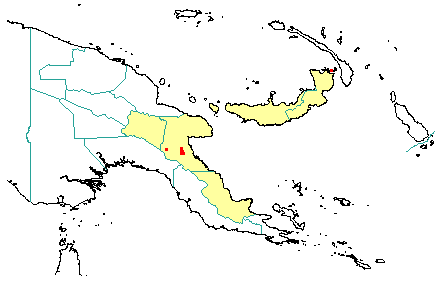
in PNGplants database
PNGTreesKey – Firmiana papuana Mildbr. |
Barry Conn (NSW) & Kipiro Damas (LAE).
Guide to trees of Papua New Guinea
Copyright held by the authors, National Herbarium of New South Wales, and Papua New Guinea National Herbarium
Botanische Jahrbucher für Systematik, Pflanzengeschichte und Pflanzengeographie Vol. 62: 362 (1929)
Other Literature: J. Havel, Forest Botany, Part 2 Botanical Taxonomy 189 (1975) Fig. 51-53.
Family: Malvaceae
Dicotyledon
Timber Group: Occasional timber species (but little used because logs split open too easily) Tradename: Lacewood
Field Characters: Large canopy tree (up to 45 m high); Bole cylindrical (up to c. 100 cm diam.); straight (bole up to c. 25 m long); buttresses buttresses present (buttresses up to 2 m high); spines spines absent; aerial roots aerial roots absent; stilt roots stilt roots absent; Bark green or grey, slightly rough or smooth, slightly fissured or pustular, lenticels elongated vertically or rarely lenticels rounded/swelling; Subrhytidome (under-bark) green; less than 25 mm thick, 15.0-25.0; bark blaze consisting of one layer; strongly aromatic; pleasant; outer blaze pale orange, white, or yellow, with stripes (white streaks), fibrous; inner blaze pale orange, white, or yellow, with stripes (white streaks), fibrous; bark exudate (sap) present, colourless, not readily flowing (spotty), colour not changing on exposure to air, not sticky; terminal buds not enclosed by leaves.
Indumentum: Complex hairs absent; stinging hairs absent; mature twig indumentum (hairs) present, hairs dense to sparse.
Leaves: Leaves spaced along branches, spiral (leaves occurring singly at a node and arranged spirally up the branchlet), simple (a leaf composed of a single blade); petiole present, not winged, attached to base of leaf blade, not swollen; leaves broadest below middle to broadest at or near middle, 7.0-17.0 cm, 7.0-12.0 cm; symmetric, entire, dissected or lobed (slightly (margin sometimes slightly extended at end of one of the secondary veins that originate from base of lamina) to not dissected or lobed, palmately lobed (irregularly (very slight), acuminate (shortly) or bluntly mucronate, venation palmate, secondary veins open, prominent, intramarginal veins absent; leaves lower surface dull pale green, upper surface dark green (glossy), indumentum (hairs) present, indumentum (hairs) dense (on lower surface); absent; domatia absent; stipules absent.
Flowers: Inflorescence axillary, flowers on a branched axis, cones absent; flowers unisexual, unisexual with male and female flowers on the same plant, stalked, flowers with many planes of symmetry, 15.0-30.0 mm long, diameter large (more than10 mm diam.) (9-15 mm diam.); perianth present, with all sepals and/or petals (hence tepals) similar, inner perianth yellow or mauve; 5, some or partly joined; stamens 5, absent, joined, free of the perianth; ovary superior, carpels partially joined, by base, locules 3-5; styles free, 5.
Fruits: Infrutescence arranged on branched axis, fruit 30.0-70.0 mm long, 25.0-30.0 mm diam., purple or pale brown, not spiny, non-fleshy, simple, dehiscent, follicle; seeds (1-) 2-5, about 10 mm long (up to c. 8 mm long), not winged (note: fruit of separate 1-seeded winged follicles), broad (as wide as long) (surface wrinkled), seed 1-10 mm diam. (c. 8 mm diam.).
Distribution: Morobe, Eastern Highlands, Northern & New Britain.
 | Botanical records in PNGplants database |
Notes: Notes The genus Firmiana was previously classified in the family Sterculiaceae.